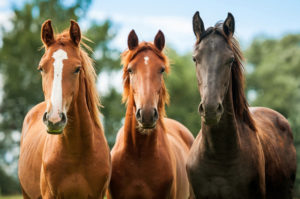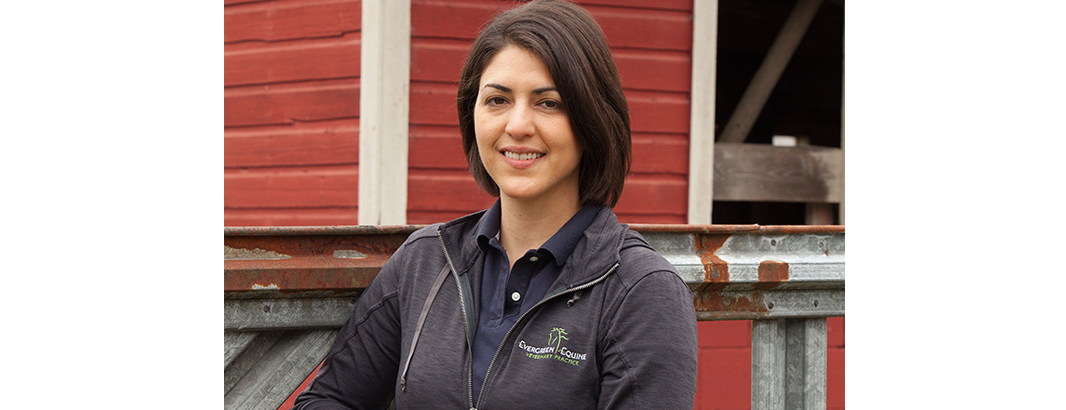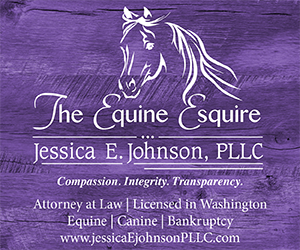Help Prevent the Spread of Contagious Disease
by Dr. Lindsay Helvey
 As winter thaws into spring, we start preparing for show season and fun gatherings with friends. Although it’s a time to be excited about riding and competing, it’s also a time when your horse can be exposed to diseases that will shorten your riding season. Like children coming back to school after a vacation, a contagious bug can wreak havoc on a naive immune system and spread to the rest of the household. Horses are affected by many different viruses and bacteria that can be transmitted through direct or indirect contact from an infected horse.
As winter thaws into spring, we start preparing for show season and fun gatherings with friends. Although it’s a time to be excited about riding and competing, it’s also a time when your horse can be exposed to diseases that will shorten your riding season. Like children coming back to school after a vacation, a contagious bug can wreak havoc on a naive immune system and spread to the rest of the household. Horses are affected by many different viruses and bacteria that can be transmitted through direct or indirect contact from an infected horse.
The most common infectious diseases of the respiratory tract in horses are caused by equine influenza (flu), equine herpesvirus (rhino) and streptococcus equi (Strangles). Equine influenza and herpesvirus are viruses that typically cause a runny nose, cough, fever and lack of energy. Streptococcus equi is a bacteria that can cause similar symptoms, but also swelling of the lymph nodes around the throat latch area. Swelling of the lymph nodes in this area leads to difficulty breathing and hence the common name “Strangles.” Since these diseases affect the upper respiratory tract, they are usually spread through nose to nose contact, drinking from a shared water source, through coughing or snorting, or by touching a contaminated object (including your hands, clothing, tack and equipment).
Most healthy horses that become infected develop mild to moderate symptoms, clear the infection, and have a temporary natural immunity. However, a percentage of horses can become very sick and require extensive medical attention. Through the cost of medical bills and canceled events, a simple infection can become a financial and emotional burden.
Biosecurity precautions at the show and your barn can help prevent your horse from becoming sick and limit the spread of disease. Simple measures that easily become routine can make a big difference when it counts. Here are some key points to keep in mind:
For the show or event:
- Vaccinate: Administer a minimum of 2 weeks before your horse will be exposed to new horses. Antibiotics do not work against viruses, but boosting a horse’s immune system will help lessen the symptoms. Consult your veterinarian to determine the best vaccine schedule for your horse.
- Keep to Yourself: Avoid the common areas and stay away from shared water sources.
- Equipment: Use your own tack, buckets, rakes, etc. If you must share, wipe down the equipment with disinfectant between horses.
- Hands: Wash or apply hand sanitizer to your hands between handling horses or before working with your own after being in a common area.
When you return home or when a new horse arrives:
- Isolate: Have a separate barn or segregated stall at end of the aisle with no neighboring horses and decreased foot traffic.
- Monitor: Watch for changes in attitude, appetite, water consumption, manure production, and signs of coughing or runny nose and eyes.
- Temperature: Take and record your horse’s temperature twice a day for 7 days. 98.0°–101.5° is a healthy range.
- Limit Contact: Designate one caretaker for the horse who will work with the horse last.
- Hands: Wash with soap or use hand sanitizer immediately after handling.
- Equipment: Continue to use separate tack, buckets, rakes, etc. that are labeled and only used for individual horses.
- Water: Don’t dip the end of water hose into buckets or allow horse to drink from shared water sources.
- Turnout: Keep in a separate fenced area not used by other horses, and with no neighboring horses that come into physical contact.
- Time: Isolate new or traveling horses for 2-3 weeks before introducing to the rest of the barn or using common areas.
- Disinfect: Clean equipment and stall with a detergent, followed by dilute bleach (1part bleach to 10 parts water) or commercial disinfectant after the designated isolation time.
Establishing biosecurity measures also protects horses that stay home. Make sure to vaccinate these horses, as they will be exposed to everything the traveling horses bring back. If you have concerns or questions regarding biosecurity or your horse’s health, contact your veterinarian. S/he can advise you on specific biosecurity measures for your barn and how to treat your horse. Have a healthy enjoyable season.
Originally Published April 2017 Issue

Originally from California, Dr. Helvey is a graduate of Colorado State University College of Veterinary Medicine and Biomedical Sciences. After earning her doctorate, she completed an internship at Glenwood Veterinary Clinic, the largest referral hospital in western Colorado, where she experienced a wide variety of challenging and rewarding cases. For the past five years, Dr. Helvey worked in a busy ambulatory practice before relocating to Snohomish. Although she enjoys all aspects of general practice, Dr. Helvey has special interests in preventative medicine, lameness, and equine dentistry, and she continues to expand her knowledge by receiving additional training in corrective dentistry and specialty extractions.
Contact Dr. Helvey at Evergreen Equine Veterinary Practice in Snohomish, Washington.
www.evergreenequinevet.com (360) 568-1114






